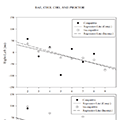Abstract
Left–right keypresses to numerals are faster for pairings of small numbers to left response and large numbers to right response than for the opposite pairings. This spatial numerical association of response codes (SNARC) effect has been attributed to numbers being represented on a mental number line. We examined this issue in 3 experiments using a transfer paradigm. Participants practiced a number magnitude-judgment task or spatial stimulus–response compatibility task with parallel or orthogonal stimulus–response dimensions prior to performing a parity-judgment task. The SNARC effect was enhanced following a small–left/large–right magnitude mapping but reversed following a small–right/large–left mapping, indicating that associations between magnitude and response defined for the magnitude-judgment task were maintained for the parity-judgment task. The SNARC effect was unaffected by practice with compatible or incompatible spatial mapping for the parallel spatial task but was larger following up–right/down–left mapping than up–left/down–right mapping for the orthogonal spatial task. These results are inconsistent with the SNARC effect being due to a horizontal number line representation but consistent with a view that correspondence of stimulus and response code polarities contributes to the effect.
